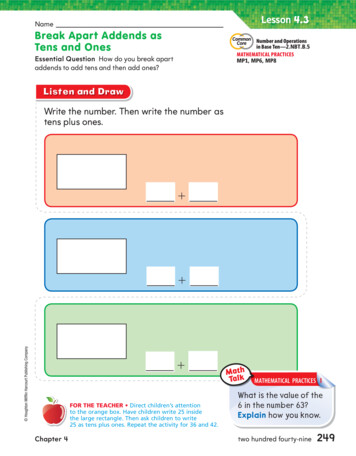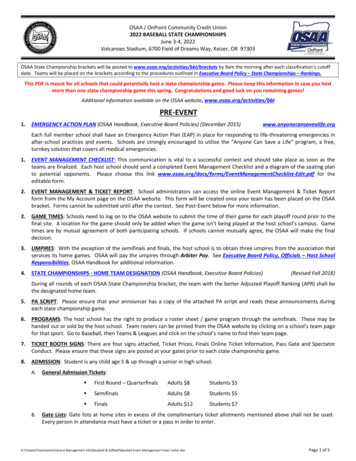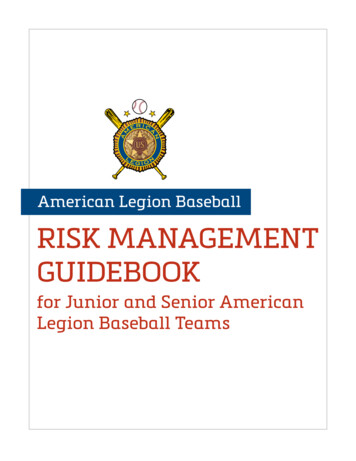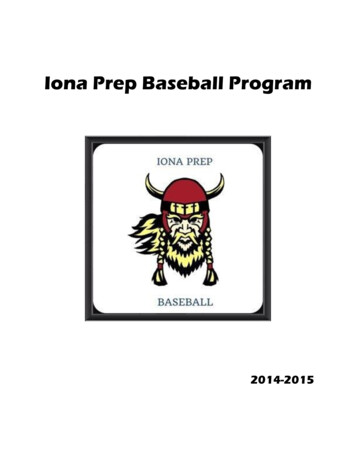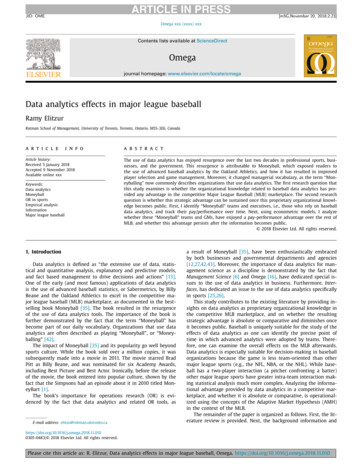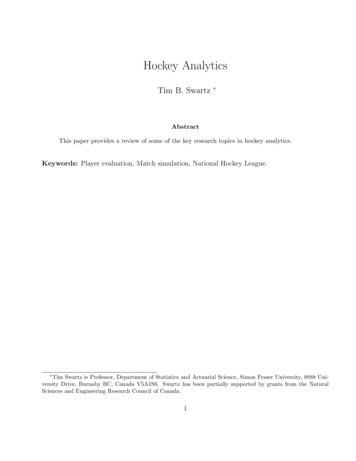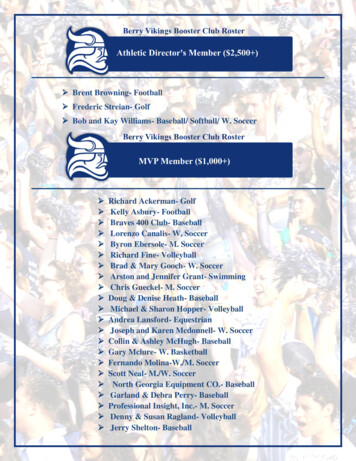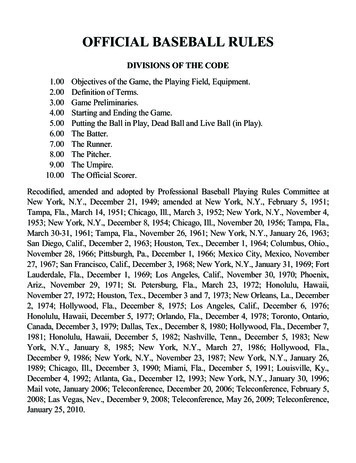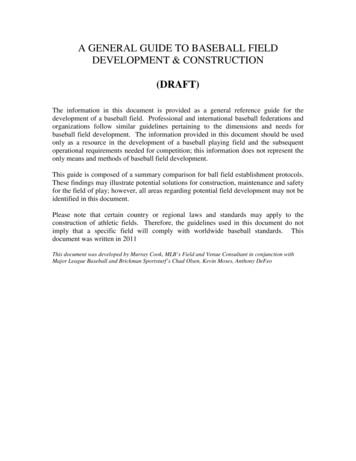
Transcription
A GENERAL GUIDE TO BASEBALL FIELDDEVELOPMENT & CONSTRUCTION(DRAFT)The information in this document is provided as a general reference guide for thedevelopment of a baseball field. Professional and international baseball federations andorganizations follow similar guidelines pertaining to the dimensions and needs forbaseball field development. The information provided in this document should be usedonly as a resource in the development of a baseball playing field and the subsequentoperational requirements needed for competition; this information does not represent theonly means and methods of baseball field development.This guide is composed of a summary comparison for ball field establishment protocols.These findings may illustrate potential solutions for construction, maintenance and safetyfor the field of play; however, all areas regarding potential field development may not beidentified in this document.Please note that certain country or regional laws and standards may apply to theconstruction of athletic fields. Therefore, the guidelines used in this document do notimply that a specific field will comply with worldwide baseball standards. Thisdocument was written in 2011This document was developed by Murray Cook, MLB’s Field and Venue Consultant in conjunction withMajor League Baseball and Brickman Sportsturf’s Chad Olsen, Kevin Moses, Anthony DeFeo
PLANNING FOR A BASEBALL FIELDThere are many steps to developing a baseball field and for it to be successful the site willrequire research. It’s important to have input from all parties that will be involved withthe field(s) development. The following are all very important components of the playingfield that should be reviewed and discussed with all of the users. Before you moveforward with these specifics, you should consider the following field development issues.They will help you define your goals in developing the field that best suits your budgetand your needs Issues to consider when choosing a site for your baseball field?o Location of the area within a city, farm land, city owned lando Field Orientation- Is the sun going to set in the wrong part of the field?o Accessibilityo Convenience for players and publico Transportation issueso Parkingo Safety of players and guestso Multi purpose use considerationso Opportunity for future growthFor what age group or classification will this field or fields be used by?How often will they be used and during what time of yearType of construction. High performance or RecreationalWho is going to maintain the field?o Value engineeringo Cost of development –Design serviceso Value Engineering (Again)o Cost of maintenanceIs the facility to be used for high level play?Field Lighting and at what level.
Dugouts, fencing, batters eyes etc.Topography of the existing areasNatural drainage of the areaAmount of grading and fill necessarySoil of the area (the foundation subsoil and surface topsoil)Have they completed an soil borings to evaluate sub soil conditionsCondition of existing turfUtilities, Electricity , SewageStormwater issues and flood plain concerns.Construction Time Line – When do you plan to have the field used for play?Location of the area – Community, downtown, etc.Accessibility for public, deliveries etc.Transportation issues- traffic bus schedules, train etc.Hotels- what is the closest and can they provide your needs for tournamentsSynthetic or Natural turfSafetyEstablishing Field Dimensions
Determining the size of the field or facility can be difficult. When planning for the field,the layout must meet the regulation standards of the age bracket or professional standardsfor your proposed level of play.For a regulation size field, a parcel of land approximately 560 feet (170 meters) by 560feet (170 m) with room to orient the field properly will provide a seating bowl for 3000 to3,500 spectators. Additional land would be necessary for car parking.You should plan to allow 355-425 square feet (35-40 square meters) per car for accessdrives, parking areas, service drives and pedestrian ways.
Diagram 1 outlines a regulation 90ft. field layout of infield area.Based on the level of baseball that you have decided to build for your community, youwill need to conform to certain league standards if you are planning to host specifictournaments for age groups. This graph will assist you in determining the potential fieldsizes.
Diagram 2CategoryLeftCenter FieldRight FieldPitchingDistanceDistance BetweenBases321'400'321'60'6"90'(98 m)(122 m)(98 m)(18.44 m)27.4 m)321'400'321'60'6"90'(98 m)(122 m)(98 m)(18.44 m)27.4 m)321'400'321'60'6"90'(98 m)(122 m)(98 m)(18.44 m)27.4 m)280'350'280'60'6"90'(85.4 m)(106.7 m)(85.4)(18.44 m)(27.4 m)250'315'250'54'80'(76.3 m)(96.1 m)(76.3 m)(16.46 m)(24.38 m)200'200'200'46'60'(60.9 m)(60.9 m)(60.9 m)(14 m)(18.29 m)FieldSeniorCompetitionAges 19-21Ages 17-18Ages 15-16Ages 13-14Ages 11-12Sizing your field for ConstructionAgain this is only a short list of design and construction issues to consider beforebuilding the field. Many of these issues trigger other discussions regarding seating forfans, restrooms, concession areas, locker rooms, ticket booths etc. Obtain the services ofa design team and field consultant as soon as possible to help you with a plan. We highlyrecommend a reputable baseball field consultation firm to help guide you along theprocess.There are numerous ways to build a field and a main consideration is how small or largeyour budget is for the project. The type of programming ( usage) and amount ofprogramming must be considered when selecting the type of field you plan to construct.Part of building a field is sizing it properly. A regulation field size is approximately 110,000 sq fto This would include high school to professional level and players 16 yearsold and up A field for 13 to 15 year old kids would have an outfield fence closer to the homeplate. These fields would be closer to 90,000 sq ft A field for 12 and under age is 60,000 sq ft.
Determining the Type of Field(s) you need and can affordThere are basically four types of fields that can be constructed. Native Soil fields - most typical among residential communities.Modified Native Soil Fields - These are fields that have taken the native soils anadded other materials such as sand and organics to improve the soil structure.Sand Based Fields - These are high end use fields that are constructed using amodified sand base. These fields drain the best of all three and will be used moredue to their draining characteristics. Another level of the sand based fieldconstruction is one that also adds minor amounts of topsoil to sand based systems.Synthetic Turf fields - These fields are designed for multiuse sports. There arespecific types of synthetics used for baseball. Selecting the turf for a baseballrequires extensive research. There are numerous Synthetic turf companies aroundthe world and some are better for baseball and softball than others.Native soil fields, Amended Native Soil Fields or Sand-based systems must bedetermined early in the design process. Soil testing should be completed early in theprocess to determine the type of soils you have at the site. You may even consider one ofthe new synthetic turf types depending on your budget and climate. For a native soilfield the grade should slope away in all directions from the base of the pitcher's mound.The field surface should slope away from the mound at a grade of .75% up to 1.0% fornatural native type soil fields. This grade should be maintained into foul territory andbeyond to the outfield fence with a slight increase once it has passed over the foul linesby ¼ %. In comparison sand based systems with a subsurface drainage system, wouldrequire surface grading of .5 to .75. This type of field will give you much better usageand playability.Grading a field properly during construction also requires the use of laser gradingequipment. To accurately establish grades based on the design you will use there needsto be some type of grading point of reference on the site. Sometimes this is called abenchmark and everything is graded using that reference point.
The photo above is a dual- laser grading set up. There are different types of laser graders.If you cannot afford to use a laser grader there is the old fashion method which is using atransit, survey equipment and string lines. The fields for the Beijing 2008 Olympics werebuilt using this method. Although not exact it is much more accurate than using youreyes.The MLB Regulation states: "The infield should be graded with a gradual slop from thebaselines to the pitcher’s plate, which shall be 10" above the home plate.” More than a1% grading would make it difficult to build a baseball field properly because it effects theelevations between the pitcher’s mound and plate. It is possible at 1% but you need tomake sure the base areas and home plate are all kept at the same elevation and you canobtain the slope required under the rules of mound construction.
On many professional level fields the infield and outfield are practically flat. Theseprofessional field systems are sand based meaning they are constructed of 8 to 10 inchesof sand on top of 4 inches of gravel. This type of design requires a sub drainage systemthat includes a series of drain tiles that is very extensive to allow the rain water to flowquickly through the turf and into a storm water system. These materials are tested forbridging to ensure they provide a stable playing surface.Surveyors should be asked to make continuous grade checks throughout the constructionprocess on all graded materials. The surveying should be completed during all phases ofconstruction to validate the sub base, irrigation, root zone, infield, mounds, home plateand bullpens are installed at the proper heights. Sloping the field slightly will speedsurface drainage from the diamond area, including the runoff from the tarps that cover themound, plate and sometimes the entire field. However, some groundskeepers feel thatthis isn't necessary if a grade of 1% is true and there is not a pronounced ridge at the edgeof the grass built up by wind or over dragging.Again there are differences in opinions related to field design and construction and theMLB rule book only sets required measurements and recommendations for grass locationand orientation. The general consensus above is to build it with a consistent slope anduse the best materials so it plays safely.Let’s recap some of the discussion above. Remember to: Determine type , size and number of events Design field to accommodate the usage Develop maintenance plan to provide consistent and safe playing conditions Develop budget - confirm funding is in place. Then Start construction!
Building Fields to Meet the Level of PlayTo provide a range of field level construction techniques we will break down the fieldinto 3 levels of play and construction.1. Professional (sand based system)- Typically a sand based field with drainagestone and a series of drain tiles under the entire field2. Collegiate (Sand based or amended system) - Typically a sand based fieldwith modifications. It could have partial sub drainage3. Recreational (Native soil system)- Typically a native soil field, possiblyamended sand based soil, no underdrain system4. Synthetic Turf - Normally with cut-outs for baseball at the bases home plate andpitcher’s mound)All fields should be constructed with an automatic irrigation system. Aconsistent water source is required to maintain healthy and safe fields of play.In some areas synthetic fields require irrigation to cool the turf and also willrequire a water source for managing the clay areas.The general difference in the above field types is the drainage design and the level ofmaintenance you have available. Specification development for building the field willalso be a required component of the field you will build. Selecting the correct sub soilmaterials and growing mediums will determine your maintenance budget. Theseselections will dictate integrity, cost and type of surface you will plan to install for theentire field including the infield, mounds, warning track and turf type etc.As mentioned there are various types of fields and they all can be categorized under ageneric name called the Natural Turf System. Your field can be composed of a Nativesoil root zone material, a modified native soil root zone material or a sand based rootzone material. All of these Natural Turf Soil Systems are composed of three layers. Thesub base, the growing medium and the turf.The growing medium for a Native Soil field System is 6 to 8 inches of root zone. Thegrowing medium can be as simple as a screened topsoil blended with amendments and reapplied to the surface. The sod or seed is the final layer. For natural grass playing fields,the native soils may need to be treated and conditioned with organic material. A testingagent with a background in this type of soil analysis should be hired to test the nativesoils and provide a recommendation for soil amendments in turf areas of the infield.The Sand based field (Normally most expensive) is composed of three layers as well.Sand based systems allow for rain water to pass through the soils. Drainage performanceis determined by the modifications to the native soil and by the amount of slope on thesurface. The sub base (which is in both native and sand based) is rolled and compacted toa specific standard for stability. In sand based sub drainage field there is a series of drainpipe covered in a 4 inch layer of pea gravel and the 8-12 inch sand base layer covers the
pea gravel which bridges so it will not fall through into the gravel layer. There arespecific types of specifications for these materials as well as underground irrigationsystems. The finish surface again is sodded or seeded.Sand based systems are basically large “putting greens” designed to allow the water toflow through the turf and root zone layer into a series of sub drains. This has been theideal method of natural turf construction for many years but it comes with a higher initialcost than native soil field construction. The sub base areas of these type fields arecomposed of gravel and a series of drains lay throughout the field that remove waterquickly. In some cases over 5 inches in an hour.The goal is to design the field so it will drain as quickly as possible without losing theintegrity of the playing surface. Using a native soil construction with no sub drains willrequire more of a finish grade to allow the rain water to flow. This unfortunately cancause construction issues with the infield if you are trying to build a regulation field.Using Forms to Separate the Materials during ConstructionDuring the construction of the field it is highly recommended to reduce contamination ofsoils. For example: When you place the sand next to the infield clay or warning trackmix during construction, you should keep a clean separation of these materials so thegrass is growing ins sand and your clay is not mixed with your infield mix or warningtrack etc. This can be managed by installing “forms” on the field before the soils are
placed. I have seen wooden forms (as shown in the photo above), metal forms or evenplastic forms. After the materials are placed you would remove the forms from the field. Isuggest they be removed before you lay the grass. In the photo the forms are placed afterthe gravel layer is applied to the field and they are set to the height of the root zone andinfield mix allowing for more accurate placement of soils.Turf and Sod SelectionIt’s important to take the time to select the proper grass for your field. Options areseeding, sodding, sprigging or synthetic. Seeding is an option if you have the time togrow it in properly and the resources to do it right. On Many projects the schedules donot allow time for seed establishment. In the southern states sprigging is common ofBermuda type turf grasses. Small stolens are planted and the cultivated to spread andgrow over the entire field. I have seen sprigs become fully established in a month. This isa great method of turf growth because you eliminate the rootzone barrier you bring inwhen you sod. In most cases natural turf sod is used and installed in big rolls. These bigrolls are 30-50ft long and 3-4 feet wide, an entire field of 100,000 sq ft can be laid in acouple days. When selecting your grass you need to choose a turf type suitable to yourregion. There are thousands of turf types around the world and many have beenspecifically designated for your climatic region.This is a hand type sprigging methods but they also have machines that perform the sameapplication.
A Suggested Order of Field Design, Development and Construction. Hire your sports turf manager, or field consultant. Develop maintenance budget and begin to order equipment. A reputablefield contractor can install a professional level field in 45 days so it’simportant to be ready to take care of it when they lay down the grass. Secure the services of a qualified surveyor and field contractor and or field projectdirector. Making small mistakes during the planning period could result in costlymaintenance problems down the road. If you’re sodding the field, locate the grass source and determine the type youneed based on your area. It’s important to do this early in the process so you canhave the turf tested and growing properly before it harvested. Determine elevation and grade lines to confirm what existing grades are and howthey will change to allow your field to drain properly. Have a soil analysis completed to find out what type of soils your site consists of.You will want to send the soil sample to a certified testing service thatunderstands the difference between testing soils for roads, builds and sports fields.They are very different tests. They will test for particle size, percolations, solublesalts and PH. Roto-till hard pan and subsurface soil if your site proves to be an impermeablesurface. Install irrigation system mainlines and outlets. Excavate and pour concrete footings for light towers, dugouts, stands and lockerroom. Install the drain tile system, drain outlets, sewer system. Install electric lines, cables, outlets to light towers, dugouts and stands Lay out stabilized areas; haul in aggregate for warning tracks, paths to home platein front of dugouts, coach’s box, on deck, and fungo circles.
Replace or prepare native topsoil - from soil analysis formula, mix in soilstructure amendments. This material can be stockpiled on site. Again if you arebuilding a sand based field system you will remove all of the soil from theexisting field and replace it with a pea gravel drainage system and sand based rootzone for the growing medium.Sterilize native soil materials if possible. Taking care of the weeds in this materialcan save a lot of money trying to spray out weeds in the future.Roto-till the soil for uniform and thorough mixing. Rework the area to gradeelevations with laser graderRecheck grade elevations with surveyor's report.Roll the area to a firm soil.Install backstops, fences, scoreboard, flag pole, foul line marker.Build a pitcher’s moundSpread a starter fertilizerFinish grading with laser device.Remeasure diamond and recheck grade elevations carefully.Set the home plate, pitchers plate, base anchors.Mark all grass lines, circles, arcs and boxes with chalk or lime.Plant the area (seed, vegetatively, or sod)Build your bullpens and install warning trackFinish construction and installation of dugouts, light towers, stands, locker rooms,showers, toilets, storage space, concession stands, and parking lotsInfield Skin ConstructionMany developers and field contractors make the mistake of believing that the skinnedarea should be flat and have no grade. In reality these areas require some surfacedrainage. They are sometimes pitched about .4% towards the 95 arc. This allows the
water to move off the field’s rain cover after a storm. Because of high use, weather etc,the centre of the base paths which are normally made from the same infield clay has atendency to become “swale like” and hold surface water. If the .5% fall is carriedthrough the baseline, there would only be a ¼ inch drop on the 6 foot wide baselines andbehind home plate. These grade tolerances are not noticeable and improve surfacedrainage dramatically. Application of the infield clay is critical and should be applied thesame way you grade the roost zone material. Use a laser grader.The Infield skin or clay area should be very firm but also have the ability provide safefooting for all ages. This balance of material, water and maintenance is more art thanscience. The material on the infield, baselines should be the same and should be at least5” deep. The mix should be premixed and to approximate percentages of:60% sand30% clay10% siltThe Infield Clay or skin mixture is normally red in color and a soil conditioner oramendments can be applied to the infield material and implemented at a depth of ¼ inch.
Although the % of the sand, clay and silt is very important the particle size is equally asimportant. Obviously the material should have no particles larger than 1/8 of inch inwidth and no thicker than 1/16 of an inch.How to Build a Pitcher’s MoundThe pitcher’s mound is the focal point of the field as it relates to the game. Games arewon and lost by how well the pitcher throws the ball. There are numerous ways to builda mound - there is no one right way. However, all pitchers’ mounds have similarmaterials. When choosing the materials and products to build the field with two bullpens,remember that five pitcher’s plates will be required: one for the main mound plus two ineach bullpen. The Pitcher’s Plate is also called a pitching rubber or pitcher’s box.Pitcher’s plates are made of rubber and are 24 inches long and 6 inches wide. The platesnormally come in a block form with a steel tube through the middle to provide support.Typical providers of these plates are Hollywood or Jack Corbet/Schutt style bases.Tools and materials required for constructing a mound: plate compactorhand tampTransit – a surveying instrument with a telescope that can be rotated completelyaround its horizontal axis; used for measuring vertical and horizontal angles.6-foot level – a calibrated glass tube containing liquid with an air bubble inside,mounted on a frame and used for measuring whether surfaces are horizontal.landscape rakegarden rakean assortment of shovels - round point and flatstring24-inch metal spikes2-3 plywood plankshammerwater and water hose6-10 tons of hard infield mix (50% clay, 10% silt, 40% sand) per mound6-10 tons of regular infield mix (30% clay, 10% silt, 60% sand) per moundcart or loader to transport the infield mix around the field1-2 wheelbarrows or small carts3-4 volunteersIn some cases, clay bricks are used to build the mound. The photo shows the use ofmoist clay bricks. Hard clay comes in bags and bricks. Either will work fine but formaintenance, the bags are preferred.
Clay BricksIn order to locate the proper position of the pitcher’s plate on a regulation baseball field,the home plate location must be identified by a hired surveyor. Once that is completed,following the steps below to identify the location of the pitcher’s plate. A tape measure,string and five wooden stakes will be needed.1. The apex of home plate will be used for all measurements of the infield. Afterdetermining the location of the home plate, make sure the field distance andangles can be achieved without obstruction.2. From the back point of the home plate, measure exactly 60 ft. 6 inches from theapex (or tip) of the home plate to the front of the pitcher’s plate. Hammer onestake at this location. For youth baseball fields, adjust the field dimensionsaccordingly.3. With the tape measure and string, measure a distance of 127 feet, 3.375 inchesfrom the apex of home plate. This measurement will be the center of second base.Hammer one stake at this location.Although the pitching distance is 60 ft. 6 inches from the front of the pitcher’s plate to theapex of the home plate, the actual circle around the mound is measured from a point thatis 18 inches in front of the pitcher’s plate. The mound should be built within the 9-footradius from this point. A common mistake of placing the pitchers plate in the centre of
the mound is very common. Remember to double check your measurements to ensureyou do not build your mound in this fashion.
Properly Constructed Pitcher’s MoundNext, set the distance, height and exact location needed to establish the mound using atransit or laser leveling tool. The top of a pitcher’s plate on a professional field mound is10 inches above the top of the home plate. Check this measurement using a string fromthe center of home plate, over the pitcher’s mound to second base. Keep this stringavailable as it will be a guide to determine if the plateaus (the tops of) of each area arecentered.4. After setting the distance to the pitcher’s plate, find the circumference (edge orperimeter) of the mound. For example, on a regulation baseball field, thepitcher’s plate is 60 feet, 6 inches from the apex of home plate. From the front ofthe pitcher’s plate, measure 18 inches. This will be the center of the mound. Thediameter of the mound is 18 feet on a regulation baseball field.5. It is now important to remove four inches of existing material from the circle.Lay several plywood planks around the edge of the mound so the turf will not bedamaged while the mound is constructed. Using strings and 24-inch spikes canhelp keep the construction on track after setting the mound height. A stringstretched across the mound from first base to third base with spikes placed at thebase of the mound can help. If a transit tool is not available, a "line level" may beused. This instrument is not 100% accurate but is adequate. Use this cross line tocheck height as needed.6. Use the plate compacter, as shown in the photo to the right, to harden the area.
7. Use the regular infield mix to build the base. The base is the area directly underthe plateau of the mound. When the mound is completed, the plateau will be 5feet wide and 36 inches deep. To build up the plateau, raise the base in one-inchincrements. Water and tamp (or pack) the area after each increment until theheight of the mound is approximately four inches from the finish height.8. Next, place the pitcher’s plate in the desired location. Using a string stretchedfrom home plate to second base, identify the center of the mound and the center ofthe pitcher’s plate. It is helpful to mark the center of the pitcher’s plate with a penand lineup that mark with the string.9. Check the level and height of the mound using a transit.10. Begin to add the hard infield mix around the pitcher’s plate to set it in place. Usethe hand tamp during this process. A small level is also helpful to ensure that thepitcher’s plate is level.11. Continue to build the plateau in 1-inch increments, alternating the process ofadding the clay, tamping and watering, until the desired height is achieved.Always follow with rolling or compacting a small 1’ton roller is a choice.
12. Once the plateau is built to the desired height, the construction of the slope willbegin. Remember the fall (or slope) is one inch per foot towards home plate.13. Lay a straight plywood plank (measuring approximately 10 feet in length) at thefront of the pitcher’s plate and mark the plank every 12 inches, starting the firstmark 6 inches from the pitcher’s plate. Raise the end of the plank that fallstoward home plate so it is level with the pitcher’s plate.14. The entire landing area in front of the pitcher’s plate is made from the hard infieldmix. This area is approximately 7 feet wide and 8 feet long. The sides and backof the mound can be made from the infield mix, using the same procedure used tobuild the pitcher’s mound until the slopes are completed. Check the height of theplateaus throughout the process.15. Maintaining moisture is the key to a proper pitcher’s mound. The mound shouldnot dry out and crack. The goal is to keep the mound moist so it is pliable, givingthe pitchers superior footing. The use of a tarp secured with spikes to cover themound when the field is not in use is strongly suggested.Mound Soil ConsistencyMound soils should be kept moist yet firm. Detailed Moisture management is key tohaving proper clay areas. The area where the pitcher’s foot lands after the pitch isextremely important and needs to be kept consistent with moisture. Finding a local clayprovider for this material will benefit most organizations when building fields. Forinternational construction projects, clays can be found in various locations such as brickfactories and pottery facilities.If the mound dries out and begins to crack, it can be moistened and the levels can beconstructed again, but this process may take a few days. Depending on the severity of the
problem, the field may not be playable while the repairs take place. Keeping the moundcovered by a tarp when not in use and using a throwing mat during practices will helpmaintain the moisture content.When the mound becomes wet during significant rainfall, a material such as calcinedclay can be added to the top and raked in lightly. Please note that it is important toremove this material entirely after the game and replace it with new infield mix. If this isnot done, the mound clays will not bond properly, and the holes that pitchers use forstable footing will develop too quickly and become deeper than needed. Each field willrequire two bullpens on each side of the field. You will need five home plates: one forthe main field and two for each bullpen.Construction of the Home Plate AreaTypes of clay used i
Determining the Type of Field(s) you need and can afford. There are basically four types of fields that can be constructed. Native Soil fields - most typical among residential communities. Modified Native Soil Fields - These are fields that have taken the native soils an added other materials such as sand and organics to improve the soil structure.
